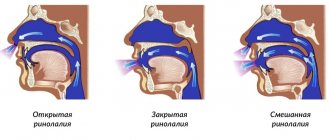Mental retardation - what is mental retardation?
Mental retardation (MRD) is a child’s developmental delay in accordance with the calendar norms of his age, without impairment of communication and motor skills. ZPR is a borderline condition and may indicate serious organic brain damage. In some children, mental retardation may be the norm of development, a special mentality (increased emotional lability).
If mental retardation persists after age 9, the child is diagnosed with mental retardation. The slowdown in the rate of mental development is due to the slower maturation of neural connections in the brain. The cause of this condition in most cases is birth trauma and intrauterine fetal hypoxia.
Causes of mental retardation (MDD) of organic origin
- Organic brain damage in the prenatal period: hypoxia, fetal asphyxia. Caused by a number of factors: improper behavior of a pregnant woman (taking prohibited substances, malnutrition, stress, lack of physical activity, etc.)
- Viral infectious diseases suffered by the mother. More often - in the second and third trimester. If a pregnant woman has suffered from whooping cough, rubella, cytomegalovirus infection, and even ARVI in early pregnancy, this entails a much more severe developmental delay.
- Aggravated obstetric history: trauma during childbirth - the child gets stuck in the birth canal; if labor is weak, stimulants, epidural anesthesia, forceps, vacuum are used, which is also a risk factor for the newborn.
- Complications during the natal period: prematurity, infectious or bacterial disease during the newborn period (up to 28 days of life)
- Congenital abnormalities of brain development
- An infectious or viral disease suffered by a child. If the disease proceeds with complications in the form of meningitis, encephalitis, neurocysticercosis, mental retardation most often becomes a diagnosis of mental retardation (made after 9 years).
- External factors - complications after vaccination, taking antibiotics
- Domestic injuries.
The most common cause of mental retardation (MDD) is birth trauma. You can read more about birth trauma here.
Signs of mental development delay (MDD) in children
The game is characterized by a lack of imagination and creativity, monotony, monotony. These children have low performance as a result of increased exhaustion. In cognitive activity, the following are observed: weak memory, instability of attention, slowness of mental processes and their reduced switchability.
Symptoms of mental retardation (MDD) at an early age (1-3 years)
Children with mental retardation have a decreased concentration of attention, a delay in speech formation, emotional lability (“fragility of the psyche”), communication disorders (they want to play with other children, but they can’t), decreased interests according to age, hyperexcitability, or, conversely, lethargy.
- Delay in age norms for speech formation. Often a child with mental retardation later begins to walk and babble.
- They cannot differentiate an object (“show the dog”) by the age of one year (provided that the child is being taught).
- Children with mental retardation cannot listen to the simplest rhymes.
- Games, cartoons, listening to fairy tales, everything that requires understanding does not arouse interest in them, or their attention is concentrated for a very short time. However, a 1-year-old child normally does not listen to a fairy tale for more than 10-15 minutes. A similar condition should alert you at 1.5-2 years.
- There are disturbances in coordination of movements, fine and gross motor skills.
- Sometimes children with mental retardation begin to walk later.
- Profuse drooling, protruding tongue.
- Children with mental retardation may have a difficult character; they are irritable, nervous, and capricious.
- Due to disturbances in the central nervous system, a child with mental retardation may have problems falling asleep, staying asleep, and the processes of excitation and inhibition.
- They don’t understand the spoken word, but they listen and make contact! This is important for differentiating mental retardation from more severe disorders such as autism.
- They do not distinguish colors.
- Children with mental retardation at one and a half years old cannot fulfill requests, especially complex ones (“go into the room and bring a book from the bag”, etc.).
- Aggression, tantrums over trifles. Due to mental retardation, babies cannot express their needs and emotions and react to everything by screaming.
What is the difference between ZPR and UO?
- The main difference between mental retardation and mental retardation is the former’s ability to be reversible, while mental retardation cannot be cured.
- ZPR is characterized by partial manifestations, that is, deviations from the norm in a child are not observed in all areas, but only in some aspects of his life. Manifestations of MR are total, and the difference between the baby and his peers is observed in almost everything.
- Children diagnosed with mental retardation demonstrate new skills in leaps and bounds. As a result of irreversible damage to the cerebral cortex, representatives of the UO are distinguished by hierarchical development.
Differences demonstrated during learning
There are also differences between the two diagnoses in the area of cognitive abilities. Thus, children with mental retardation, with proper attention from their parents, can show a fairly rapid development of the ability to abstract from a particular situation, independently analyze something, compare objects, process information, and generalize.
Children diagnosed with mental retardation have reduced cognitive abilities that are almost impossible to improve. They do not have the skill to establish cause-and-effect relationships; they cannot make comparisons or generalize existing facts.
Mental retardation and mental retardation (differences, table)
| ZPR | Mental retardation |
| The speed and level of thinking can be corrected with the right approach | No adjustments help speed up the development process |
| There is a possible negative impact on intelligence: hearing, vision, coordination, as well as level of attention and perception | There is an impact on the thought process |
| Great importance is given to play activities, with the help of which the child’s condition can be improved; he himself willingly joins in the gameplay | Shows absolute indifference to almost any game |
| Highly emotional, able to concentrate on completing the task at hand | The emotional sphere is poorly developed; performing a specific task is accompanied by frequent distractions for the child |
| Capable of mastering fine art skills | Show no interest or ability in the visual arts. When carrying out the learning process, in rare cases they can draw simple figures, arbitrary lines, chaotically written letters |
| Appearance and behavior characteristics are not dysplastic | May be characterized by severe dysplasticity: disturbances in body proportions, strabismus, severe awkwardness, the presence of six fingers, a noticeable slowdown in speech, stuttering and other defects |
| Do not have pronounced manifestations in their neurological status | Asymmetry of the face and tongue may be noted; A venous network may be visible in some areas of the face |
Signs of mental retardation in preschool and school age (4-9 years)
When children with mental retardation grow up and begin to associate and feel their body, they may complain of headaches, often get motion sickness in transport, and may experience nausea, vomiting, and dizziness.
Psychologically, children with mental retardation are difficult to accept not only by their parents, but also suffer from this condition themselves. With mental retardation, relationships with peers are poor. From misunderstanding, from the inability to express themselves, children “close themselves in themselves.” They can become angry, aggressive, and depressed.
Children with mental retardation often have problems with intellectual development.
- Poor understanding of counting
- Can't learn the alphabet
- Frequent motor problems and clumsiness
- In the case of severe mental retardation, they cannot draw and cannot hold a pen well
- Speech is slurred, monotonous
- The vocabulary is scanty, sometimes completely absent
- They do not interact well with peers; due to mental retardation, they prefer to play with children
- The emotional reactions of schoolchildren with mental retardation do not correspond to their age (they become hysterical, laugh when it is inappropriate)
- They do poorly at school, are inattentive, and mentally gaming motivation predominates, as in younger children. Therefore, it is extremely difficult to force them to study.
When should you see a doctor?
The differences between mental retardation and mental retardation can only be accurately identified by a specialist based on examination and examination. It is not possible for parents to do this on their own.
You should consult a doctor immediately if your child has:
- mental, emotional or physical lag behind his peers;
- sudden outbursts of aggression;
- obvious problems with concentration;
- pronounced body imbalances.
It is extremely important to find a competent specialist with sufficient experience and qualifications.
These are the specialists of the pediatric department of the clinic of JSC "Medicine" (clinic of academician Roitberg), the building of which is located in the center of Moscow, at the address: 2nd Tverskoy-Yamskaya lane, building 10, a five-minute walk from the Mayakovskaya metro station.
Our clinic employs experienced neonatologists, child psychologists, pediatricians and other specialized specialists. They work on the latest equipment, which allows them to identify with maximum accuracy the slightest features in the health status of a particular child.
You can make an appointment by calling our 24-hour phone number or using the feedback form.
Difference between mental retardation (MDD) and autism.
Mental retardation may correlate with autism spectrum disorders. When diagnosis is difficult and the features of autism are not so pronounced, they speak of mental retardation with elements of autism.
Differentiation of mental retardation (MDD) from autism:
- With mental retardation, the child has eye contact; children with autism (namely autism, not an autistic disorder such as Asperger's syndrome) never make eye contact, even with their parents.
- Both children may have no speech. In this case, a child with mental retardation will try to address the adult with gestures, point a finger, hum or gurgle. With autism, there is no interaction with another person, no pointing gesture, children use an adult's hand if they need to do something (press a button, for example).
- With autism, children use toys for other purposes (they spin the wheels of the car instead of moving it). Children with mental retardation may have problems with educational toys, they may not fit their figures into the holes of the required shape, but already at one year old they will show emotions towards plush toys, they can kiss and hug them if asked.
- An older child with autism will refuse contact with other children; with mental retardation, children want to play with others, but since their mental development corresponds to that of a younger child, they will experience problems with communication and expression of emotions. Most likely, they will play with younger children, or be shy.
- A child with mental retardation can also be aggressive, “heavy,” silent, and withdrawn. But what distinguishes autism from mental retardation is the lack of communication in principle, plus fear of change, fear of going out, stereotypical behavior and much more. For more information, see the article “Signs of Autism.”
Diagnostic features
Only a specialist can diagnose the presence of a particular disease in a child, therefore, when the first thoughts appear that something is wrong with the baby, you should immediately. In most cases, when there is really no cause for concern, a consultation with an experienced pediatrician is sufficient.
However, in order to be completely sure, it is best to show the child to a pediatric neurologist or neurologist.
In some cases, it is necessary to contact several specialists at once: a neonatologist, neurologist, defectologist, neurosurgeon, speech therapist, psychologist or psychotherapist.
The specialist will conduct a thorough in-person examination, review your medical history and prescribe a series of examinations to make an accurate diagnosis. These may include the following:
- CT;
- MRI;
- Dopplerography of cerebral vessels;
- electroencephalography, etc.
With the help of tests, the functioning of the organs of hearing, vision, thinking abilities, concentration, and fine motor skills will be assessed. The specialist may also be interested in whether there were cases of similar diseases in the family, whether any of the relatives suffered from genetic diseases, how the mother’s pregnancy proceeded, etc.










